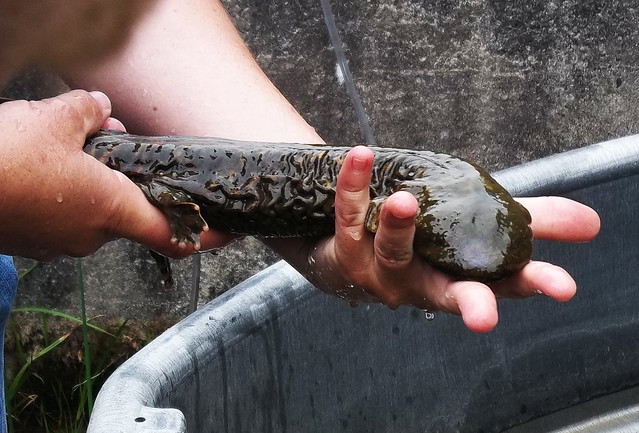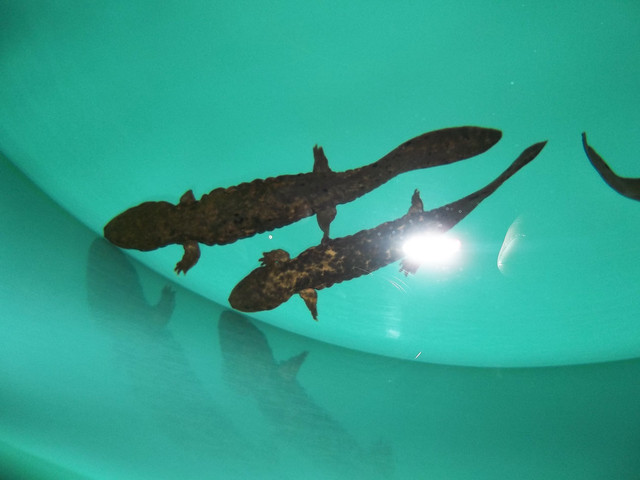“He’s so ugly he’s cute” is an expression I’ve heard my mother use many times.
It was usually reserved for a particularly mutt-ly dog. You know – bulging eyes, snaggletooth under bite, hair that sprouts up in all the wrong places. Usually these dogs win our hearts – but not show ribbons.
That’s kind of how it is with the Eastern Hellbender Salamander

Now, if you haven’t seen a Hellbender, brace yourself. It didn’t get the nickname Snot Otter for looking cuddly.

Hellbenders are fully aquatic salamanders
The Eastern Hellbender is a fully aquatic salamander, and should not be confused with a mudpuppy (they, too, are aquatic salamanders, but they’re smaller and have external gills). The Hellbender is one of the largest salamanders in the world – and it lives right here! Our slimy giant can register up to 2 feet in length, has a big wide mouth that looks like a small child may have drawn it on, and beady little eyes. And it is a beautiful thing that will win your heart if you get to know it.
Not every state has a Hellbender, but we do!
Hellbenders are one of those fascinating creatures that make our region so particularly amazing. They have a very limited range for habitat, and they like clean running streams. They have these rippled folds of skin that run along both sides of their body that allows them to pull the oxygen out of water, so you’re likely to see them chilling in a riffle.
There are only two varieties or subspecies of hellbenders—the eastern hellbender (Cryptobranchus alleganiensis alleganiensis)—and both have been quietly dissappearing since about the 1980s.

Map courtesy of DGIF 2004 we wish there was a more current map to share!
The Virginia Game and Inland Fisheries website lists the Eastern Hellbender as a “Federal Species of Concern.” Polluted water ways and dam construction are among its biggest threats – but so are we.
Virginia Wildlife Action Plan Rating Tier II lists it as – Very High Conservation Need – Has a high risk of extinction or extirpation. Populations of these species are at very low levels, facing real threat(s), or occur within a very limited distribution. Immediate management is needed for stabilization and recovery.
They don’t pass the fluffy-puppy test
So they don’t always get love and attention from people. Some think they are poisonous or dangerous but they are not. Some think they eat fish from the stream but they do not, they primarily dine on crayfish andhave also been known to eat insects, snails, minnows and worms.Some people are just put off by their appearance and instead of being released from a wayward fishing hook, they are thrown onto the bank to suffocate and die.
If it really takes cute to win your affection, please check out their little Hellbender toes – five little grippers on each hind foot and four on each front foot. Come on! He has toes!
Mr Wonderful
If being one of the absolute coolest things in nature isn’t enough to win you over, consider that the male protects the eggs for up to 84 days waiting for them to hatch. He even sways and swishes his tail to provide oxygen to the eggs. How sweet is that?Hellbenders are known to live to 30 years in the wild and over 50 years in captivity.
Yes Virginia, Hellbenders are real!
You probably won't be able to easily find one in the wild, so we recommend a trip to the Hungry Mother State Park!
When you visitHungry Mother State Parkask your interpreter about them.
The origin of the name is uncertain, but some say it’s because when you see one you’re hell-bent on getting away from it. Let’s hope that as of this moment, you’ll be hell-bent on getting to know more about the unique and wondrous hellbender.Read more about the eastern hellbenderhere.
We hope you take some time to look into those beady eyes and fall in love
